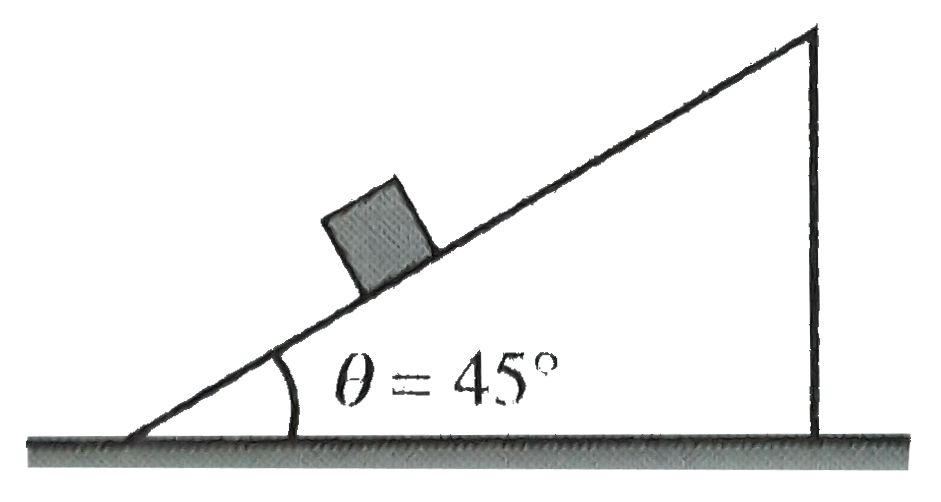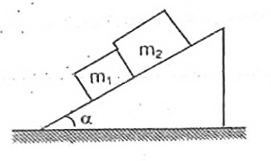Find the minimum force required to keep a block of mass m in equilibrium on a rough inclined plane with inclination α and coefficient of friction μ(<tanα).
To find the minimum force required to keep a block of mass m in equilibrium on a rough inclined plane with inclination α and coefficient of friction μ (where μ<tanα), we can follow these steps:
Step 1: Identify the forces acting on the block
The forces acting on the block are:
- The gravitational force mg acting vertically downward.
- The normal force N acting perpendicular to the inclined plane.
- The frictional force f acting parallel to the inclined plane, opposing the motion.
Step 2: Resolve the gravitational force
The gravitational force can be resolved into two components:
- Along the incline: mgsinα
- Perpendicular to the incline: mgcosα
Step 3: Write the expression for the normal force
The normal force N is given by:
N=mgcosα
Step 4: Determine the limiting friction
The limiting friction fmax is given by:
fmax=μN=μ(mgcosα)
Step 5: Set up the equilibrium condition
For the block to be in equilibrium, the net force along the incline must be zero. Thus, we have:
F+fmax=mgsinα
Where F is the applied force.
Step 6: Substitute the expression for limiting friction
Substituting the expression for limiting friction into the equilibrium condition gives:
F+μ(mgcosα)=mgsinα
Step 7: Rearrange to find the applied force F
Rearranging the equation to solve for F:
F=mgsinα−μ(mgcosα)
F=mg(sinα−μcosα)
Step 8: Minimize the force F
To minimize the force F, we need to consider the angle θ at which the force is applied. The normal force will change with the angle of application of the force F. The new normal force can be expressed as:
N=mgcosα+Fsinθ
Step 9: Substitute the new normal force into the friction equation
The new frictional force will be:
f=μN=μ(mgcosα+Fsinθ)
Step 10: Set up the new equilibrium condition
The new equilibrium condition becomes:
F+μ(mgcosα+Fsinθ)=mgsinα
Step 11: Solve for F
Rearranging this equation leads to:
F(1+μsinθ)=mgsinα−μmgcosα
F=mg(sinα−μcosα)1+μsinθ
Step 12: Minimize the denominator
To minimize F, we need to maximize the denominator 1+μsinθ. This can be done by differentiating with respect to θ and setting the derivative to zero.
Step 13: Find the optimal angle
Setting the derivative to zero gives:
tanθ=μ
Step 14: Substitute back to find the minimum force
Substituting tanθ=μ back into the expression for F gives:
Fmin=mg(sinα−μcosα√1+μ2)
Final Result
Thus, the minimum force required to keep the block in equilibrium is:
Fmin=mg(sinα−μcosα)√1+μ2
The forces acting on the block are:
- The gravitational force mg acting vertically downward.
- The normal force N acting perpendicular to the inclined plane.
- The frictional force f acting parallel to the inclined plane, opposing the motion.
The gravitational force can be resolved into two components:
- Along the incline: mgsinα
- Perpendicular to the incline: mgcosα
The normal force N is given by:
N=mgcosα
The limiting friction fmax is given by:
fmax=μN=μ(mgcosα)
For the block to be in equilibrium, the net force along the incline must be zero. Thus, we have:
F+fmax=mgsinα
Where F is the applied force.
Substituting the expression for limiting friction into the equilibrium condition gives:
F+μ(mgcosα)=mgsinα
Rearranging the equation to solve for F:
F=mgsinα−μ(mgcosα)
F=mg(sinα−μcosα)
To minimize the force F, we need to consider the angle θ at which the force is applied. The normal force will change with the angle of application of the force F. The new normal force can be expressed as:
N=mgcosα+Fsinθ
The new frictional force will be:
f=μN=μ(mgcosα+Fsinθ)
The new equilibrium condition becomes:
F+μ(mgcosα+Fsinθ)=mgsinα
Rearranging this equation leads to:
F(1+μsinθ)=mgsinα−μmgcosα
F=mg(sinα−μcosα)1+μsinθ
To minimize F, we need to maximize the denominator 1+μsinθ. This can be done by differentiating with respect to θ and setting the derivative to zero.
Setting the derivative to zero gives:
tanθ=μ
Substituting tanθ=μ back into the expression for F gives:
Fmin=mg(sinα−μcosα√1+μ2)
Thus, the minimum force required to keep the block in equilibrium is:
Fmin=mg(sinα−μcosα)√1+μ2
Topper's Solved these Questions
Similar Questions
A block of mass m moves with constant speed down the inclined plane of inclination θ. Find the coefficient of kinetic friction.
 View Solution
View SolutionA block of mass m is kept on an inclined plane is angle inclination θ(<ϕ), where ϕ= angle of friction. Then :
 View Solution
View SolutionA block of mass m attached with a an ideal spring of force constant k is placed on a rough inclined plane having inclination θ with the horizontal and coefficient of friction μ=1/2tanθ, Initially the block is held stationary with the spring in its relaxed state, find the maximum extension in the spring if the block is released.
 View Solution
View SolutionA hollow sphere of mass m and radius R is rolling downdard on a rough inclined plane of inclination θ. If the coefficient of friction between the hollow sphere and incline is μ, then
View SolutionA block of mass m=3kg slides on a rough inclined plane of cofficient of friction 0.2 Find the resultant force offered by the plane on the block
 View Solution
View SolutionFind the minimum value of horizontal force (F) required on the block of mass m to keep it at rest on the wall. Given the coefficient of friction between the surfaces is μ.
View SolutionFind the force required to pull a block of mass 100kg up an incline of 8∘ at a uniform speed of 5m/s. The coefficient of friction between the block and the plane is 0.3.
View SolutionA block slides down on inclined plane (angle of inclination 60∘ ) with an accelration g/2 Find the coefficient friction
 View Solution
View SolutionTwo blocks of masses m1andm2 are kept touching each other on a rough fixed inclined plane of inclination α. Coefficients of kinetic friction between the inclined plane and the block m1 is k1 and between the inclined plane and block m2 is k2. Find the force of interaction between the blocks in the process of motion.
 View Solution
View SolutionA block of mass m is at rest on a rough inclined plane of angle of inclination θ. If coefficient of friction between the block and the inclined plane is μ, then the minimum value of force along the plane required to move the block on the plane is
View Solution

